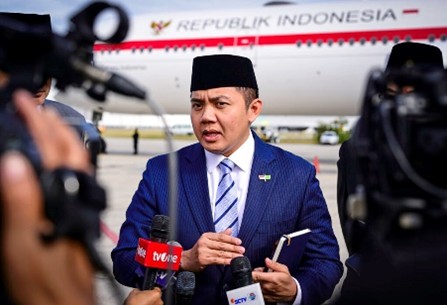BNPB, UNDRR Special Representative Inspect Disaster-Safe School in E. Jakarta

The National Disaster Management Agency (BNPB) and the United Nations for Disaster Risk Reduction (UNDRR) pay a visit to a disaster-safe school at SDN 13 Klender state elementary school in East Jakarta, Thursday (02/03). (Photo by: Documentation of Cabinet Secretariat)
The National Disaster Management Agency (BNPB) and Special Representative of the Secretary-General of the United Nations Office for Disaster Risk Reduction (UNDRR) Thursday (02/03) paid a visit to a disaster-safe school at SDN 13 Klender state elementary school in East Jakarta.
SDN 13 Klender state elementary school has become a disaster-safe pilot project school for the communities and the surrounding environment which has also received disaster management training and assistance program from the Indonesian Causation Resilience Foundation (YRKI).
The inspection activity began with a presentation made by the disaster preparedness team for SDN 13 Klender, followed by discussions with the BNPB, the UNDRR, and the students.
Deputy for System and Strategy of the BNPB Raditya Jati urged the teachers and students to disseminate disaster knowledge to the communities around the school and where they reside.
“The disaster-safe school serves as a means for teachers and students to learn more about their environment and to make them an agent that provides information to families and the surrounding communities. This is a great thing to do to make people aware of disaster literacy, considering that we live in disaster-prone areas,” he said.
In the meantime, the UNDRR Special Representative of the Secretary-General of Mami Mizutori said that the visit aimed to see firsthand the efforts of the disaster-safe school at SDN 13 Klender since the school has implemented disaster safety management.
Through the disaster-safe school, she said, teachers and students are expected to carry out teaching and learning activities safely and comfortably to produce a smarter next generation.
“Creating a country that is safer from disasters and creating safe schools are two of our goals because schools are places for students to study in order to create a better future,” Mami said.
In addition, Head of the Disaster Preparedness Team for SDN 13 Klender Utin Sutinah explained that the school has routinely held training and drills for handling disasters such as earthquakes and fires.
According to Utin, the school wants to revive the spirit of the team to invite more members.
“The school’s disaster preparedness team initially consisted of about 60 students. There are currently only 10 students left because they have graduated. There has been no regeneration due to the pandemic, which causes students to study from home more often,” Utin explained.
After the discussion, the activity continued with a visit to the School Health Unit (UKS) room, evacuation route, and assembly points, as well as a mural of disaster management information in the school environment.








